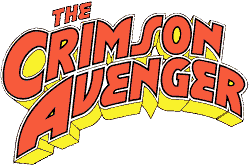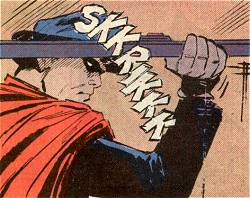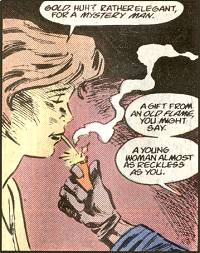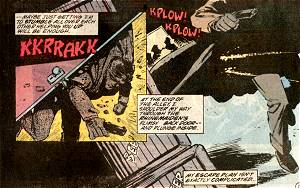The Crimson Avenger

 A store in my city recently had a huge closing sale, which is always a sad occasion. But the chance to dig through the back-issue bins for dirt-cheap runs of series I missed the first time ’round - and maybe even a rarity suddenly within my price range - is a pleasant silver lining to that cloud. So it was that - checking in vain for a copy of Creatures of the Id (the first appearance of Madman) - I stumbled across a set of all four issues of The Crimson Avenger, written by Roy Thomas - a respected writer - and his wife Dann in 1988. And with the sale discount in effect, I figured it was easily worth an investment of 60 cents. Total.
A store in my city recently had a huge closing sale, which is always a sad occasion. But the chance to dig through the back-issue bins for dirt-cheap runs of series I missed the first time ’round - and maybe even a rarity suddenly within my price range - is a pleasant silver lining to that cloud. So it was that - checking in vain for a copy of Creatures of the Id (the first appearance of Madman) - I stumbled across a set of all four issues of The Crimson Avenger, written by Roy Thomas - a respected writer - and his wife Dann in 1988. And with the sale discount in effect, I figured it was easily worth an investment of 60 cents. Total.
Heck, it turns out it would’ve even been worth cover price ($1 each).
 The Crimson - as he was originally known, and as the historically-picky Thomas insists on calling him in this story set in 1938 - was one of the earliest batch of costumed heroes to appear in comicbooks in the late 30’s, debuting in Detective Comics several issues before that guy in the bat suit. His costume: a crimson-colored eye mask and cloak, and the requisite blue suit and fedora. His “powers”: his wits, his fists, and a .45. His secret identity: newspaper publisher Lee Travis. And he was aided by his Chinese chauffeur Wing How (who, along with the the Green Hornet’s Kato, makes for a bone fide genre cliché, I’d say). As a vigilante, he was hunted by the police.
The Crimson - as he was originally known, and as the historically-picky Thomas insists on calling him in this story set in 1938 - was one of the earliest batch of costumed heroes to appear in comicbooks in the late 30’s, debuting in Detective Comics several issues before that guy in the bat suit. His costume: a crimson-colored eye mask and cloak, and the requisite blue suit and fedora. His “powers”: his wits, his fists, and a .45. His secret identity: newspaper publisher Lee Travis. And he was aided by his Chinese chauffeur Wing How (who, along with the the Green Hornet’s Kato, makes for a bone fide genre cliché, I’d say). As a vigilante, he was hunted by the police.
This story - cowritten by Dann Thomas, I should emphasise, since the husbands of spousal writing teams alway seem to get all the credit - takes place shortly after the Crimson’s debut in the waning days of 1938, and revolves around the growing global hostilities, as Japan advances through China, Germany moves into eastern Europe, and the soon-to-be-Allies hestitate to act. The Crimson finds himself in the middle of a plot he doesn’t quite grasp, with enigmatic foreign women, strange objects, and shadowy conspirators weaving around him.
 It’s a mystery, but not in the sense of a whodunnit novel, where all the clues are laid out for the reader to try to decipher before the detective does in the final chapter. The Thomases drop mere hints and bits of foreshadowing that make sense only in retrospect; they’re only clues in the sense that you might wonder “why did they tell/show us this?” Instead, the reader gets to follow along with the hero, lost in the maze, wondering when the pieces will drop into place. In issue #4, of course. {smile}
It’s a mystery, but not in the sense of a whodunnit novel, where all the clues are laid out for the reader to try to decipher before the detective does in the final chapter. The Thomases drop mere hints and bits of foreshadowing that make sense only in retrospect; they’re only clues in the sense that you might wonder “why did they tell/show us this?” Instead, the reader gets to follow along with the hero, lost in the maze, wondering when the pieces will drop into place. In issue #4, of course. {smile}
Actually some of the mystery is unveiled in #3, but without telegraphing how the end-game will play out. They leave that hanging for the final chapter. In a serial story like this - especially a mystery - there’s often a need to recap “what’s gone before”, but rather than intruding upon the progressing story, the Thomases did that in the text pages at the back of each issue. This made the experience of reading them all one right after the other more enjoyable. But I think that, even if I didn’t already have the whole set on the couch next to me, I was interested enough after each issue that I would’ve picked up the next a month later.
I know Roy Thomas in those days was very fond of retconning to fill in the many continuity gaps left by the original Golden-Age writers. His earlier Secret Origin story for the character was a classic example of this, tying his origin to Orson Welles’ October 1938 radio dramatisation of “War of the Worlds”… the same month the Crimson appeared on the stands. So I can’t help wondering how many of the developments in this story were devised to explain bits that appeared in later (1939 and beyond) stories featuring the character. But even if this was a motive, it doesn’t intrude on the story itself, which stands nicely on its own for someone who knows slightly more than nothing about the character’s other adventures. (Me.)
 Greg Brooks provides art that fits the story well. The action scenes are dynamic without being show-off-y or hard to follow. The many out-of-costume scenes (this really should be titled Lee Travis) are well done. And while the 1930’s settings are often hidden in shadow, when we see them they look reasonably authentic. The quality got a little shaky on the last couple issues - sketchier and sometimes-awkward figures - but it’s hard to tell whether that’s because Mike Gustovich took over some of the art, or because of whatever circumstances required him to. Not that he’d remember me, but he taught a short class in comic book art I took downtown several years before this series. He’s no superstar, but he was the first real life comics pro I’d ever met.)
Greg Brooks provides art that fits the story well. The action scenes are dynamic without being show-off-y or hard to follow. The many out-of-costume scenes (this really should be titled Lee Travis) are well done. And while the 1930’s settings are often hidden in shadow, when we see them they look reasonably authentic. The quality got a little shaky on the last couple issues - sketchier and sometimes-awkward figures - but it’s hard to tell whether that’s because Mike Gustovich took over some of the art, or because of whatever circumstances required him to. Not that he’d remember me, but he taught a short class in comic book art I took downtown several years before this series. He’s no superstar, but he was the first real life comics pro I’d ever met.)
It’s now over 61 years since the Crimson Avenger first appeared, but the character is still a pretty cool one, and the Thomases’ treatment of him back on his 50th anniversary is still a pretty good read itself. So if you run across this mini-series for a good price (and frankly, what comics shop - even one that’s not closing - is going to try charging serious money for it at this point?), it’s probably worth it.
